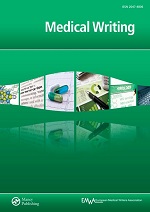
Although medical writing as a career has been around for a few decades, medical writing education is relatively new. Many medical writers end up teaching scientific or medical writing, and have built their courses and their teaching style without any training or systematic guidance. The field of medical writing is continuing to grow and new people are being attracted to it, so accredited training and a systematic method for teaching are becoming necessary.
This issue of Medical Writing is intended to help give the field of medical writing education a push in the right direction with a collection of articles on the essential competencies for medical and scientific writers and how to effectively teach them. The first three articles give guidance on what to teach to publication writers. Edward Barroga details a set of modules for publication writers and a simple evaluation system for assessing their competencies. Takako Kojima and colleagues continue with an article describing a series of lectures and group-based workshops that combine writing skills with publication ethics. Finally, Elisabeth Heseltine explains how to build an effective scientific writing workshop for non-native speakers of English.
Most people teaching medical or scientific writing come from a scientific or linguistic background and have never had specific training in education. Two articles in this issue should provide basic tools for effectively teaching medical writing. Louise Fuller gives practical tips for anyone thinking of becoming a full- or part-time medical writing trainer or for established trainers looking for new ideas, and Felicity Neilson describes the powerful learner-centred approach to teaching, where learners use what they already know to better assimilate new information.
For those interested in earning a degree in medical writing as way into a medical writing career, there are few academic programmes (see page 16 for a list). However, Dan Benau, Director of Biomedical Writing Programs at the University of the Sciences, explains that formal education from an accredited programme gives a more uniform foundation of knowledge – and therefore a better foundation for a medical writing position – than experience alone or experience combined with short-term training. In the article, Dan also shares his experience at the University of the Sciences, which should be helpful for those building new academic programmes in medical writing.
Finally, Melodie Hull describes the field of clinical writing – writing health professionals use on a daily basis – and what learners and clinical writing teachers need to know.
But wait, there's more …
In addition, to these valuable articles on medical writing education, Gabriele Berghammer and Anders Holmqvist continue their series on page layout and readability, Joseph Ross and Harlan Krumholz discuss the movement to require sharing of clinical trial data and its expected effects on medical writers, and Laura Carolina Collada Ali explains how volunteering for a professional association like EMWA can expand your skills and advance your career.
Medical Writing is evolving
Medical Writing continues to evolve. We have a few exciting new additions in this issue. First, we welcome Stephen Gilliver and Margaret Gray as our new Associate Editors. Their help and excellent work are very much appreciated. We are also thrilled to have three new regular features: Lisa Chaimberlain's Medical Communication section, Diana Raffelsbauer's Medical Journalism section, and Barry Drees' humor section, The Light Stuff.
Finally, we have heard your comments and requests and will be making further improvements to Medical Writing in 2013.
 Download the full article
Download the full article
Search
Articles
Links
Editoral Board
Editor-in-Chief
Co-Editors
Managing Editor
Victoria White
Associate Editors
Section Editors
AI/Automation
Biotechnology
Digital Communication
EMWA News
Gained in Translation
Getting Your Foot in the Door
Good Writing Practice
In the Bookstores
Publications
Medical Communications/Writing for Patients
Medical Devices
My First Medical Writing
News from the EMA
Freelancing
Pharmacovigilance
Regulatory Matters
Regulatory Public Disclosure
Teaching Medical Writing
Louisa Ludwig-Begall / Sarah Kabani
The Crofter: Sustainable Communications
Veterinary Writing
Editors Emeritus
Layout Designer
Chris Monk
 Visit the EMWA website
Visit the EMWA website